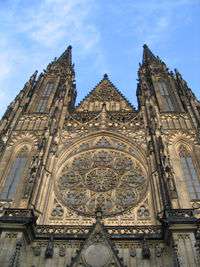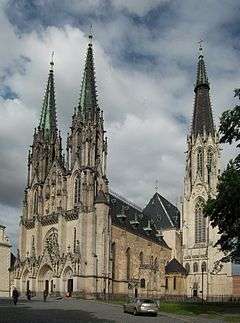Religion in the Czech Republic
| Part of a series on |
| Czechs |
|---|
 |
|
Recognized
|
Religion in the Czech Republic was dominated by Christianity until at least the first half of the 20th century; since then it has steadily declined and today the Czech Republic has one of the least religious populations in the world.
Historically, the Czech people have been characterised as "tolerant and even indifferent towards religion".[4] After the Bohemian Reformation, most Czechs (about 85%) became followers of Jan Hus, Petr Chelcicky and other regional Protestant Reformers. After the Habsburgs regained control of Bohemia, they were forcibly converted to Roman Catholicism. The Catholic Church lost the bulk of its adherents during the Communist era and continues to lose in the modern, ongoing secularization.
According to the 2011 census, 34.2% of the population stated they had no religion, 10.3% was Roman Catholic and 10.2% followed other forms of religion. 45.2% of the population did not answer the question about religion.[3] From 1991 to 2001 and further to 2011 the adherence to Roman Catholicism decreased from 39.0% to 26.8% and then to 10.3%.[5]
According to a Eurobarometer Poll in 2010,[6] 16% of Czech citizens responded that "they believe there is a God" (the lowest rate among the countries of the European Union), whereas 44% answered that "they believe there is some sort of spirit or life force" and 37% said that "they do not believe there is any sort of spirit, God or life force".
A 2012 Eurobarometer poll about religiosity in the European Union found that the largest religious affiliation in the Czech Republic was Non believer/Agnostic, accounting for 39% of Czech citizens.[7] Christianity accounted for 34% of Czech citizens. Catholics were the largest Christian group in Czech Republic, making up 29% of Czech citizens,[7] while Protestants made up 2%, and Other Christians 3%. Atheists accounted for 20% of the population and Undeclared for 6%.[7]
Census results
| 1991 | 2001 | 2011 | ||||
|---|---|---|---|---|---|---|
| number | % | number | % | number | % | |
| Roman Catholic Church | 4,021,385 | 39.0 | 2,740,780 | 26.8 | 1,083,899 | 10.3 |
| Evangelical Church of Czech Brethren | 203,996 | 2.0 | 117,212 | 1.1 | 51,916 | 0.5 |
| Czechoslovak Hussite Church | 178,036 | 1.7 | 99,103 | 1.0 | 39,276 | 0.4 |
| believers identified with another certain religions | 120,317 | 1.7 | 330,993 | 3.2 | 292,347 | 2.7 |
| believers not identified with a certain religion | 707,649 | 6.7 | ||||
| no religion | 4,112,864 | 39.9 | 6,039,991 | 59.0 | 3,612,804 | 34.2 |
| no response, unknown | 1,665,617 | 16.2 | 901,981 | 8.8 | 4,774,323 | 45.2 |
| total population | 10,302,215 | 10,230,060 | 10,562,214 | |||
Christianity
Christianity was the largest religion in the country, with virtually all Czechs being Christians until the 19th century. The Czechs gradually converted to Christianity from Slavic paganism between the 8th and the 10th century. Bořivoj I, Duke of Bohemia, baptised by the Saints Cyril and Methodius, was the first ruler of Bohemia to adopt Christianity as the state religion. Christianity has been on the decline since the 20th century and in 2011 only 13.9% of the Czech population declared themselves religious of which were 10.3% Catholics and less than 1% Protestant.[3]
Roman Catholicism

Roman Catholicism was the main form of Christianity practiced by the Czechs after their forced conversion under the Habsburgs, and throughout the 18th and 19th centuries, and was still 96.5% of Czechs in 1910. A decline in the number of Czech Catholics began after World War I and the breakup of Austria-Hungary due to a popular anti-Austrian and anticlerical mass movement.[11] During the Czechoslovak unification under a communist regime, most of the properties of the Church were confiscated by the government, although some were later returned. After the communist regime fell, 39.0% of Czechs were found to be Catholic in 1991, but the faith has continued to rapidly decline since. As of 2011 only 10.3% of the Czechs considered themselves Catholic, which is about the same as in Protestant-majority England.
The rapid trend away from Roman Catholic identification and toward irreligion in the Czech Republic stands in stark contrast to the situation in neighboring Poland or Slovakia.
Protestantism
In the 15th century, the religious and social reformer Jan Hus formed a movement later named after him. Although Hus was named a heretic and burnt in Constance in 1415, his followers seceded from the Catholic Church and in the Hussite Wars (1419–1434) defeated five crusades organized against them by the Holy Roman Emperor Sigismund. Petr Chelčický continued with the Czech Hussite Reformation movement. During the next two centuries, most of Czechs were adherents of Hussitism.
After 1526 Bohemia came increasingly under Habsburg control as the Habsburgs became first the elected and then the hereditary rulers of Bohemia. The Defenestration of Prague and subsequent revolt against the Habsburgs in 1618 marked the start of the Thirty Years' War, which quickly spread throughout Central Europe. In 1620, the rebellion in Bohemia was crushed at the Battle of White Mountain, and the ties between Bohemia and the Habsburgs' hereditary lands in Austria were strengthened. The war had a devastating effect on the local population; the people were forced to convert to Roman Catholicism.
Protestantism has declined to be a small minority in the country, with only 0.5% of the Czechs adhering to the Evangelical Church of Czech Brethren, Silesian Evangelical Church of the Augsburg Confession and 0.4% to the Czechoslovak Hussite Church.[3] Moravian Church, its theology being historically tied to the region, is present too.
Buddhism
The 2001 census counted 6,817 registered Buddhists in the Czech republic.[5] Most of the Vietnamese ethnic minority, which make up the largest immigrant ethnic group in the country, are adherents of Mahayana Buddhism. The Vietnamese mostly dwell in the cities of Prague and Cheb. Thein An Buddhist Temple in the northern province of Varnsdorf was the first Vietnamese-style temple to be consecrated in the Czech Republic, in January 2008. There are also ten Korean Buddhist temples in the Czech Republic, with three each in Prague and Brno.[12]
Ethnic Czech Buddhists are otherwise mostly followers of Vajrayana Buddhism (Tibetan Buddhism). The Vajrayana practitioners are mainly centered on the Nyingma and Kagyu schools. The Karma Kagyu tradition has established about 50 centers and meditation groups. The Diamond Way tradition of Vajrayana Buddhism, founded and directed by Ole Nydahl is active in both the Czech Republic and Slovakia. A large temple of the school is going to be built in the city of Prague.[13]
Paganism
The revived native religion of the Slavs (Rodnovery in English, Rodnověří in Czech) has a presence in the Czech Republic.[14] The largest organisation is the "Community of the Native Faith". There are also Wiccan followers,[15] and one Kemetic group in the country, Per Kemet.
Islam
With its small immigrant population, the Czech Republic has a smaller Muslim community in comparison to other European countries. The 2001 census counted 3,699 Muslims in the country.[5]
Irreligion

The Czech Republic is one of the least religious countries in the world. Vera Haberlová of STEM, for example, writes about 50% representation of atheists in Czech society. In doing so, however, it comes from simple inquiries to the question "Do you believe in God?", which also indicates a very simplistic evaluation, because a high percentage of respondents classified this way that also believe in some other "Higher Power."[16] Summary group of non-believers in God was, According to STEM survey in June 1996 Represented 48.8% of the Czech population and in July 1998 it was 47.6%. In 1994 According to STEM called themselves atheists are 21.5% of persons aged 18 years and 20.3% of those aged 15–17 years, while a further 38.2%, respectively.[16] 40.8% of people said they are not religious.[16]
According to the results of the 2001 census 7% more men were without religion than women. The age group most likely to have no religion (74%) is young people 0–30 years old, the least likely (28%) is people aged 60+ years. When categorized by education, the higher the educational level achieved, the more people were to state they had no religion.
There is an organized group of atheists in the Czech Republic, the Civic Association of Atheists, a member of the international organization of atheists Atheist Alliance International (AAI).
References
- 1 2 "Úvodní stránka - SLDB 2011". czso.cz. Retrieved 19 November 2013.
- ↑ "Population by religious belief and by municipality size groups" (PDF). Czech Statistical Office. Archived from the original (PDF) on 21 February 2015. Retrieved 23 April 2012.
- 1 2 3 4 "Population by religious belief by regions" (PDF). Czech Statistical Office. Archived from the original (PDF) on 4 November 2013. Retrieved 23 April 2012.
- ↑ Richard Felix Staar, Communist regimes in Eastern Europe, Issue 269, p. 90
- 1 2 3 "Population by denomination and sex: as measured by 1921, 1930, 1950, 1991 and 2001 censuses" (PDF) (in Czech and English). Czech Statistical Office. Retrieved 9 March 2010.
- ↑ "Eurobarometer on Biotechnology 2010 – page 381" (PDF). Retrieved 1 February 2013.
- 1 2 3 "Discrimination in the EU in 2012" (PDF), Special Eurobarometer, 383, European Union: European Commission, p. 233, 2012, retrieved 14 August 2013 The question asked was "Do you consider yourself to be...?" With a card showing: Catholic, Orthodox, Protestant, Other Christian, Jewish, Muslim, Sikh, Buddhist, Hindu, Atheist, and Non-believer/Agnostic. Space was given for Other (SPONTANEOUS) and DK. Jewish, Sikh, Buddhist, Hindu did not reach the 1% threshold.
- ↑ "Population by denomination and sex: as measured by 1921, 1930, 1950, 1991 and 2001 censuses" (PDF) (in Czech and English). Czech Statistical Office. Retrieved 2010-03-09.
- ↑ "Tab 7.1 Population by religious belief and by municipality size groups" (PDF) (in Czech). Czso.cz. Archived from the original (PDF) on 2015-02-21. Retrieved 2013-11-19.
- ↑ "Tab 7.2 Population by religious belief and by regions" (PDF) (in Czech). Czso.cz. Archived from the original (PDF) on 2013-11-04. Retrieved 2013-11-19.
- ↑ Wolfram Kaiser; Helmut Wohnout (2004). Political Catholicism in Europe 1918-1945. Taylor & Francis. pp. 181–2. ISBN 978-0-203-64246-7.
- ↑ Korean Buddhist congregations in the Czech Republic, Buddha Dharma Education Association, 2006, retrieved 2010-05-01
- ↑ S.Parker (12 January 2013). "West Wight Sangha - Biggest Czech Buddhist Centre Being Built in Prague". west-wight-sangha.blogspot.it. Retrieved 23 April 2015.
- ↑ Kaarina Aitamurto, Scott Simpson. Modern Pagan and Native Faith Movements in Central and Eastern Europe. Part II, 11: Neo-Paganism in the Czech Republic, Anna-Marie Dostalova. 2013. ISBN 1844656624
- ↑ Ryan Scott. Pagans help ring in the spring - Seasonal 'Beltane' rituals flourish in the Czech Republic. The Prague Post, 2011.
- 1 2 3 "Problémy empirického zkoumání religiozity v české společnosti". Stem.cz. 2003-02-04. Retrieved 2016-05-26.

